You’ve got to admire Activision’s balls in publishing a dead-pan first-person shooter that shamelessly dares to feature hover-tanks, rocket-boots and jetpacks.
Call of Duty: Advance Warfare ups the ante to bring us an eyeball-bursting, nose-bleed inducing visual frenzy, this is the Call of Duty franchise backed into a corner and going batshit crazy.
And I so wanted to take a steaming dump on it.

You see, I’ve watched as the Call of Duty series as it has transitioned from a fairly-historically accurate WW2 shooter onto the modern battlefield and beyond, stopping just short of laser guns and spaceships.
Each entry having to outdo the last and in turn each getting slightly more ridiculous than the one before.
I consider Call of Duty to be a great example of a series that is rapidly losing its way, having well and truly jumped the shark, nuked the fridge or whatever the cool kids are calling it these days.
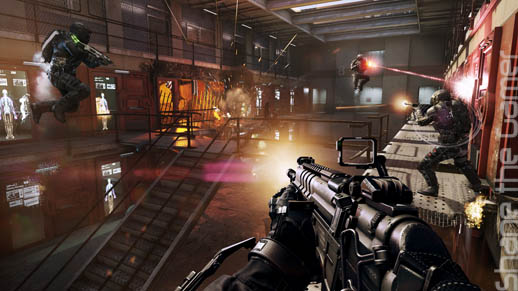
Last year’s post-apocalyptic outing, Call of Duty: Ghost, surprised me by offering up an unmistakable Call of Duty experience in a rather clichéd wrapper. It was certainly a step in the right direction following Call of Duty: Black Ops II which, if you’d forgive me, I personally found to be a bit all over the place.
Call of Duty: Advanced Warfare is the first COD game from Sledgehammer Games, the third development team that Activision has got working on the franchise.

Whether this means we now have three different game narratives/timelines going on, I’ve no idea. Previously Infinity Ward’s COD games have continued the storyline started in Call of Duty 4: Modern Warfare, whilst alternating titles from Treyarch have concentrated on the plotline that commenced in the Pacific theatre of the Second World War with Call of Duty: World at War.
Set about thirty-five years in the future, underneath its over-the-top premise, Call of Duty: Advanced Warfare examines the role and accountabilities of private military companies in a world where nations are struggling to protect their own people.

The game starts by introducing us to US Marine Private Jack Mitchell, portrayed by the ridiculously talented Troy Barker (The Last of Us, inFamous Second Son), as he is about to get airdropped into Seoul, which is currently under siege by North Korea. After a heart-in-mouth sequence, whereby Mitchell and his team are dropped in this metal rocket-propelled pod right into the thick of it, we get introduced to some of the game’s new toys.
The solders in this near-future conflict wear these ability enhancing exo-suits, special harnesses that enable them to jump higher and decent from great heights. Yes folks, they have jet packs and rocket boots.
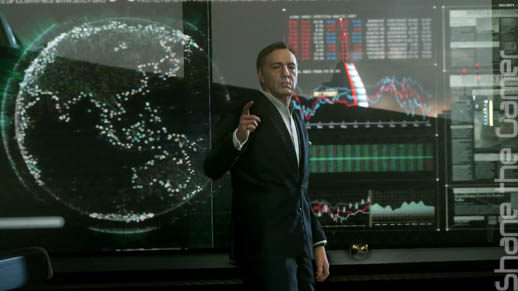
It may sound silly, but it’s actually quite cool, adding a vertical element to the proceedings that freshens up the franchise, somewhat.
Approaching the front line, we start to see more of the advanced hardware as a lumbering mech/tank on four legs steps over the squad.
After fighting through the streets, it all starts to go south when the bodies of the demolition team are spotted with the target, a parked up aerial missile delivery platform of some sort, still intact.

Mitchell and his buddy Will Irons fight their way to the explosives, lying next to their dead comrades’ bodies, and head over to blow up the launcher themselves. With the explosive charges ticking away inside the missile launcher, Irons get his arm trapped.
Despite trying to save his friend, there’s nothing Mitchell can do, Irons pushes him away as the launcher takes off and explodes. Irons is killed and Mitchell’s arm is severed at the shoulder.

At his friend’s funeral, having been discharged from the Marines, Mitchell is approached by Jonathan Irons, Will Iron’s father, who just so happens to be the CEO of the world’s largest private military contractor, the Atlas Corporation. Yes, it’s a highly unlikely scenario, but bear with me.
The death of his son has pissed off Jonathan Irons (who is played in style by Hollywood heavy-weight Kevin Spacey), leaving him critical of the US military and the leaders of the world who he feels are ultimately responsible for such devastating conflict.
Irons offers the one-armed Mitchell a job in his private army as well as a new bionic arm. Oh yes. Anyone that says the Call of Duty: Advanced Warfare isn’t sci-fi needs a slap.
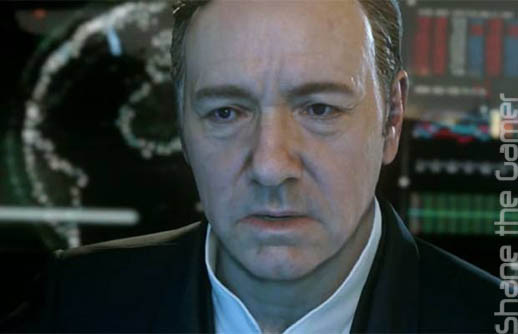
This timely alliance ties in with the emergence of an anti-western terrorist organisation called the KVA, led by their suitably monikered leader, Hades.
Mitchell with his new arm is teamed up with veteran British Atlas man, Gideon and Ex-Spetsnaz operative, Ilona, as the world turns to the Atlas Corporation to crush this terrorist threat.
Plot-wise I’m going to leave it right there, but what follows is a tale of double-crosses and shocking revelations which’ll have you fighting through forests, a Greek town and top secret installations taking for from Korea to Antarctica.

In a series that that is renowned for its frantic set pieced, Sledgehammer have pulled out all the stops this time, having our heroes rushing to escape an exploding Seattle nuclear power station as it goes into meltdown and witnessing the destruction of the Golden Gate Bridge, with our heroes still on it. This is game that throws everything at you.
As much as I don’t want to admit it, and I’m serious when I say I don’t really want to give this game such an accolade, but Call of Duty: Advanced Warfare is the most cinematic game that I’ve ever played.

The presence of an actor of Kevin Spacey’s calibre in the game, and the game having the technology available to be able to properly capture his subtle nuances is nothing short of ground-breaking.
Several times during the single-player campaign my jaw dropped. The visuals are out of this world, the performance capture is shockingly good and the whole thing is ties together with a gripping yarn that puts Hollywood’s recent action movie efforts to shame.
Once I finished the campaign, the first thing I wanted to do was start it again.
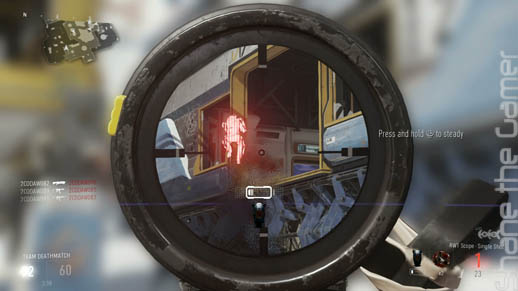
The near future setting opens up new possibilities when it comes to weaponry and gadgetry. Whilst the rifles and side-arms are reassuringly familiar, albeit with some inspired high-tech optics, the grenades and other accessories are a little more futuristic.
Smart grenades home in on targets and threat grenades highlight enemies behind cover. There’s also some more surreal devices like mute charges that block out sound and mag grips for scaling the sides of metal buildings. The bad guys have toys as well, with drone swarms that require a well-placed EMP grenade to take out.
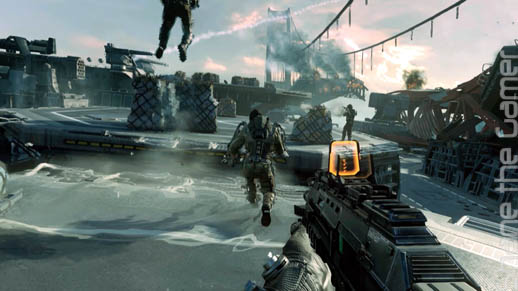
The single-player campaign is a fulfilling and manageable seven or eight hours in length, as tends to be the norm for Call of Duty games, and just enough to avoid overstaying it’s welcome. Of course, a lot of players see the single player campaign as just a prologue for the multiplayer experience.
The game’s multiplayer component comes in two flavours.
Exo-Survival is a co-operative mode whereby four players face-off against waves of increasingly difficult opponents with the odd bomb deactivation thrown in for good measure. As the match progresses more Exo-suit and weapons options become available. It’s good for a distraction or some co-op fun with a small group of friends, but the proper multiplayer mode is where you really want to be.

As usual, Advanced Warfare’s competitive multiplayer can be played online, local split-screen or via LAN.
New for this time is the Combat Readiness Program, which allows players to practice in a live fire environment against other real players, but in a way that won’t jeopardise their kill/death ratio.
All your usual Call of Duty multiplayer game types are here.
The run-of-the-mill Deathmatch and Team Deathmatch complemented by the likes of Domination and my personal favourite, Kill Confirmed, among others.
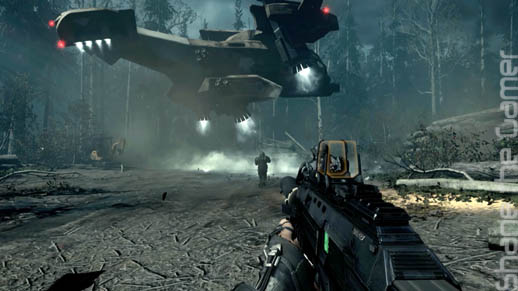
A few new modes join us for Advanced Warfare. First, we’ve got Uplink, which involves taking satellite drones to uplink points. Then there’s Momentum, which is all about capturing a series of flags with every enemy kill decreasing the length of time it takes to get the flag.
Finally Hardpoint requires teams to capture and hold hardpoints from the opposing side.
The game ships with thirteen maps featuring some interesting and diverse locations such as the base of Mexican space elevator, a dig site in South America, narrow Greek streets and an observatory on the edge of a Hawaiian volcano.

The maps this time are really designed to take advantage of the vertical gameplay introduced by the exo-suit abilities. Of course, die-hard players wishing to play without rocket-boots and jet-packs can find solace in the classic playlist selection.
This is Call of Duty on steroids.
The action has been turned up so high that the dial has broken off. It’s a great game, offering up a fantastically implausible, but shockingly good fun single player campaign.

The multiplayer element is enormously different from that of previous outings with death not just around every corner, but coming down from above as well, courtesy of those jet packs and rocket boots.
I found the vertical element a brilliant addition, even if it quickened my demise; I could at least marvel in the gymnastic abilities of my killer.
Call of Duty: Advance Warfare pulls of something rather special with a great single-player campaign and bringing an extra dimension to the multiplayer game. The game’s sci-fi direction is a bit off-putting at first, but this is still, most definitely, Call of Duty.
[jwplayer player=”1″ mediaid=”10218″]

